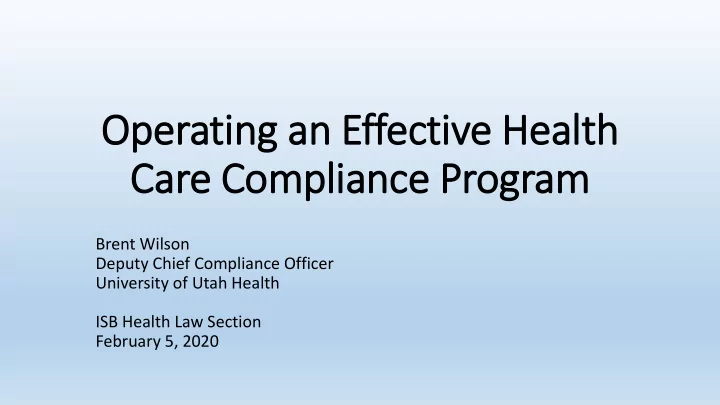

Operating a g an Effect ctive He Health Car Care Com Complian ance P Progr ogram Brent Wilson Deputy Chief Compliance Officer University of Utah Health ISB Health Law Section February 5, 2020
Why C Compliance Ma Matters • DOJ FCA Recoveries: • FY 2019: $3 billion recovered; $2.6 billion involved health care industry matters. DOJ Press Release FY 2019 • FY 2018: $2.8 billion recovered; $2.5 billion involved health care industry matters. DOJ Press Release FY 2018 • FY 2017: $3.7 billion recovered; $3.7 billion involved health care industry matters. DOJ Press Release FY 2017 • FY 2016: $4.7 billion recovered; $2.5 billion involved health care industry matters. DOJ Press Release FY 2016
Why C Compliance Ma Matters • Additionally: Stark, AKS, CMPL. • AKS violation = FCA violation • CMPL violations may also violate FCA, AKS, and Stark • Examples: • Toumey Healthcare - $237,000,000 (Stark 2015) • Adventist Health System - $115,000,000 (Stark 2015) • Kalispell Regional Healthcare System - $24,000,000 (AKS 2018) • Community Health Systems/Health Management Associates - $262,000,000 (AKS 2018) • Other Misc.: • Yates Memo: • Virtuous Cycle: • Enron, Madoff, Lehman Brothers, WorldCom, Tyco, Theranos. • Affordable Care Act:
What is a Complianc nce Program • United States Federal Sentencing Guidelines • Sentencing Reform Act 1984 • Federal Sentencing Commission • Chapter 8, Sentencing of Organizations, 1991 • 2 Components: due diligence and culture/commitment. • 7 Elements • Standards, Policies and Procedures. • Compliance Program Administration (governance and oversight). • Screening of Excluded Individuals and Entities. • Communication, Education, and Training. • Monitoring, Auditing, and Reporting. • Discipline for Non-Compliance. • Investigations and Remedial Measures.
Element 1: Policies and Procedures. • Code of Conduct: • Foundation of compliance program policies and procedures. • Compliance Policies and procedures: • • • Billing compliance FWA (e.g. FCA, AKS, Stark, CMPL EMTALA • • • Exclusion screening Conflicts of interest Discipline • • • HIPAA (Privacy and Security) Research Quality and Accreditation • • • Employment SOX FCPA • • • Other federal and state law Third party payers Auditing and Monitoring • Known risk areas • Subject to ongoing evaluation and revision.
Element 2: Compliance Program Administration (governance and oversight) • the organization's governing body must oversee compliance functions (board or board committee). • “The organization’s governing authority shall be knowledgeable about the content and operation of the compliance and ethics program and shall exercise reasonable oversight with respect to the implementation and effectiveness of the compliance and ethics program.” • Marchand v. Barnhill (Blue Bell ice cream): • A specific “high-level” employee is charged with overall responsibility for performance of the compliance program. • Specific employees are charged with responsibility for the day-to-day operations of the compliance program. • Must give adequate resources, appropriate authority, and direct access to governing authority.
Element 3: Screening for Excluded Individuals and Entities. • Organizations must screen and avoid hiring individuals or contracting with entities that have been excluded or debarred from federally funded programs. • a/k/a “debarment.” • List of Excluded Individuals and Entities (LEIE). • Note: do not often see this listed as a distinct element; Federal Sentencing Guideline Manual lists as an element in relation to any personnel with “substantial authority” in the organization. • All employees • Board members • vendors
Element 4: Communication, Education and Training. • Organizations must communicate the standards and procedures of its compliance program through effective training and education to its governing body and employees/agents. • Usual Topics: • FWA • HIPAA • Code of conduct • Specialized functions and high risk areas • Required under the Deficit Reduction Act and F.A.R.
Element 5: Monitoring, Auditing, and Reporting. • Organizations must: • regularly monitor and audit processes and operations to ensure compliance; • periodically evaluate the effectiveness of the compliance program; and • publicize methods for employees and agents to report or seek guidance on criminal conduct without fear of retaliation. • For example, compliance hotlines or anonymous reporting system. • Auditing vs. Monitoring: • Risk Assessments and Auditing/Monitoring Work Plans:
Element 6: Discipline for Non-Compliance. • Organizations must promote program and enforce consistently through: • appropriate incentives for employees and agents to perform their duties consistent with the standards of the compliance program; and • appropriate levels of discipline for criminal conduct or conduct not consistent with the compliance program. • Make reporting an employee obligation. • Must be fair and consistent.
Element 7: Investigations and Remedial Measures. • when criminal conduct is detected, the organization must: • Appropriately remediate the impact (e.g. pay restitution, self-report and cooperate with regulatory authorities); and • Take reasonable steps to prevent similar misconduct going forward. • Conducting Investigations: • Creating Attorney-Client Privilege: • Non-retaliation Policies:
Honorary Element 8: Risk Assessment. • Organizations are required to periodically (i.e., at least annually) assess the risk for criminal conduct; and • Take appropriate steps to design, implement, or modify each of the required 7 elements to reduce any identified risk for criminal conduct.
Resou ources es: • United States Sentencing Guidelines (available at: https://www.ussc.gov/guidelines) • OIG Compliance Guidance (available at: https://oig.hhs.gov/compliance/compliance- guidance/index.asp) • OIG/HCCA Measuring Compliance Program Effectiveness: A Resource Guide (available at: https://oig.hhs.gov/compliance/101/files/HCCA-OIG-Resource-Guide.pdf) • DOJ Evaluation of Corporate Compliance Programs (available at: https://www.justice.gov/criminal-fraud/page/file/937501/download) • OIG/AHIA/AHLA/HCCA Practical Guidance for Health Care Governing Boards on Compliance Oversight (available at: https://oig.hhs.gov/compliance/compliance- guidance/compliance-resource-material.asp) • Ethics & Compliance Initiative Principles and Practices of High-Quality Ethics and Compliance Programs (available at: https://www.ethics.org/resources/high-quality-ec- programs-hqp-standards/) • Holland and Hart Health Law Blog: https://www.hhhealthlawblog.com/ and webinars and “compliance boot camp.” • Fredrikson and Byron: webinars https://www.fredlaw.com/health_law_webinars/
Compliance Officer r and General Counsel • Best Practice: separate these functions. • OIG Compliance Program Guidance: • Factors for Consideration: • Industry. • Size of organization. • Skill set. • Working together: what to do. • Separation is not Feasible: what to do.
Recommend
More recommend